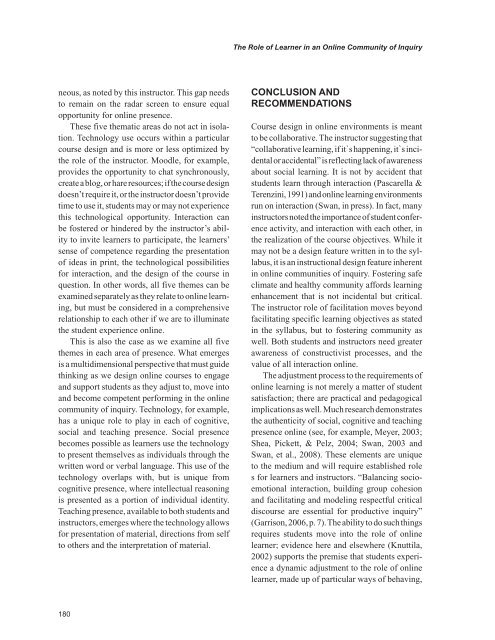Web-based Learning Solutions for Communities of Practice
Web-based Learning Solutions for Communities of Practice
Web-based Learning Solutions for Communities of Practice
You also want an ePaper? Increase the reach of your titles
YUMPU automatically turns print PDFs into web optimized ePapers that Google loves.
neous, as noted by this instructor. This gap needs<br />
to remain on the radar screen to ensure equal<br />
opportunity <strong>for</strong> online presence.<br />
These five thematic areas do not act in isolation.<br />
Technology use occurs within a particular<br />
course design and is more or less optimized by<br />
the role <strong>of</strong> the instructor. Moodle, <strong>for</strong> example,<br />
provides the opportunity to chat synchronously,<br />
create a blog, or hare resources; if the course design<br />
doesn’t require it, or the instructor doesn’t provide<br />
time to use it, students may or may not experience<br />
this technological opportunity. Interaction can<br />
be fostered or hindered by the instructor’s ability<br />
to invite learners to participate, the learners’<br />
sense <strong>of</strong> competence regarding the presentation<br />
<strong>of</strong> ideas in print, the technological possibilities<br />
<strong>for</strong> interaction, and the design <strong>of</strong> the course in<br />
question. In other words, all five themes can be<br />
examined separately as they relate to online learning,<br />
but must be considered in a comprehensive<br />
relationship to each other if we are to illuminate<br />
the student experience online.<br />
This is also the case as we examine all five<br />
themes in each area <strong>of</strong> presence. What emerges<br />
is a multidimensional perspective that must guide<br />
thinking as we design online courses to engage<br />
and support students as they adjust to, move into<br />
and become competent per<strong>for</strong>ming in the online<br />
community <strong>of</strong> inquiry. Technology, <strong>for</strong> example,<br />
has a unique role to play in each <strong>of</strong> cognitive,<br />
social and teaching presence. Social presence<br />
becomes possible as learners use the technology<br />
to present themselves as individuals through the<br />
written word or verbal language. This use <strong>of</strong> the<br />
technology overlaps with, but is unique from<br />
cognitive presence, where intellectual reasoning<br />
is presented as a portion <strong>of</strong> individual identity.<br />
Teaching presence, available to both students and<br />
instructors, emerges where the technology allows<br />
<strong>for</strong> presentation <strong>of</strong> material, directions from self<br />
to others and the interpretation <strong>of</strong> material.<br />
180<br />
The Role <strong>of</strong> Learner in an Online Community <strong>of</strong> Inquiry<br />
CONCLUSION AND<br />
RECOMMENDATIONS<br />
Course design in online environments is meant<br />
to be collaborative. The instructor suggesting that<br />
“collaborative learning, if it`s happening, it`s incidental<br />
or accidental” is reflecting lack <strong>of</strong> awareness<br />
about social learning. It is not by accident that<br />
students learn through interaction (Pascarella &<br />
Terenzini, 1991) and online learning environments<br />
run on interaction (Swan, in press). In fact, many<br />
instructors noted the importance <strong>of</strong> student conference<br />
activity, and interaction with each other, in<br />
the realization <strong>of</strong> the course objectives. While it<br />
may not be a design feature written in to the syllabus,<br />
it is an instructional design feature inherent<br />
in online communities <strong>of</strong> inquiry. Fostering safe<br />
climate and healthy community af<strong>for</strong>ds learning<br />
enhancement that is not incidental but critical.<br />
The instructor role <strong>of</strong> facilitation moves beyond<br />
facilitating specific learning objectives as stated<br />
in the syllabus, but to fostering community as<br />
well. Both students and instructors need greater<br />
awareness <strong>of</strong> constructivist processes, and the<br />
value <strong>of</strong> all interaction online.<br />
The adjustment process to the requirements <strong>of</strong><br />
online learning is not merely a matter <strong>of</strong> student<br />
satisfaction; there are practical and pedagogical<br />
implications as well. Much research demonstrates<br />
the authenticity <strong>of</strong> social, cognitive and teaching<br />
presence online (see, <strong>for</strong> example, Meyer, 2003;<br />
Shea, Pickett, & Pelz, 2004; Swan, 2003 and<br />
Swan, et al., 2008). These elements are unique<br />
to the medium and will require established role<br />
s <strong>for</strong> learners and instructors. “Balancing socioemotional<br />
interaction, building group cohesion<br />
and facilitating and modeling respectful critical<br />
discourse are essential <strong>for</strong> productive inquiry”<br />
(Garrison, 2006, p. 7). The ability to do such things<br />
requires students move into the role <strong>of</strong> online<br />
learner; evidence here and elsewhere (Knuttila,<br />
2002) supports the premise that students experience<br />
a dynamic adjustment to the role <strong>of</strong> online<br />
learner, made up <strong>of</strong> particular ways <strong>of</strong> behaving,



